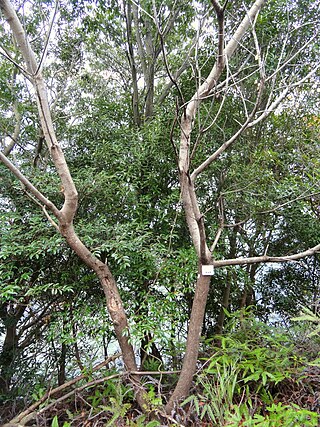
Lauraceae, or the laurels, is a plant family that includes the true laurel and its closest relatives. This family comprises about 2850 known species in about 45 genera worldwide. They are dicotyledons, and occur mainly in warm temperate and tropical regions, especially Southeast Asia and South America. Many are aromatic evergreen trees or shrubs, but some, such as Sassafras, are deciduous, or include both deciduous and evergreen trees and shrubs, especially in tropical and temperate climates. The genus Cassytha is unique in the Lauraceae in that its members are parasitic vines. Most laurels are highly poisonous.

Cinnamomum cassia, called Chinese cassia or Chinese cinnamon, is an evergreen tree originating in southern China and widely cultivated there and elsewhere in South and Southeast Asia. It is one of several species of Cinnamomum used primarily for its aromatic bark, which is used as a spice. The buds are also used as a spice, especially in India, and were used by the ancient Romans.

Cinnamomum is a genus of evergreen aromatic trees and shrubs belonging to the laurel family, Lauraceae. The species of Cinnamomum have aromatic oils in their leaves and bark. The genus contains approximately 250 species, distributed in tropical and subtropical regions of South Asia, Southeast Asia, East Asia and Oceania/Australasia. The genus includes a great number of economically important trees used to produce the spice of cinnamon.

Camphora officinarum is a species of evergreen tree indigenous to warm temperate to subtropical regions of East Asia, including countries such as China, Taiwan, Vietnam, Korea, and Japan. It is known by various names, most notably the camphor tree, camphorwood or camphor laurel.

Cinnamomum tamala, Indian bay leaf, also known as tejpat, tejapatta,Malabar leaf, Indian bark, Indian cassia, or malabathrum, is a tree in the family Lauraceae that is native to India, Bangladesh, Nepal, Bhutan, and China. It can grow up to 20 m (66 ft) tall. Its leaves have a clove-like aroma with a hint of peppery taste; they are used for culinary and medicinal purposes. It is thought to have been one of the major sources of the medicinal plant leaves known in classic and medieval times as malabathrum.

Borneol is a bicyclic organic compound and a terpene derivative. The hydroxyl group in this compound is placed in an endo position. The exo diastereomer is called isoborneol. Being chiral, borneol exists as enantiomers, both of which are found in nature: d-borneol and l-borneol.

Quercus variabilis, the Chinese cork oak, is a species of oak in the section Quercus sect. Cerris, native to a wide area of eastern Asia in southern, central, and eastern China, Taiwan, Japan, and Korea.

Cinnamomum burmanni, also known as Indonesian cinnamon, Padang cassia, Batavia cassia, or korintje, is one of several plants in the genus Cinnamomum whose bark is sold as the spice cinnamon. It is an evergreen tree native to southeast Asia.

Pinus morrisonicola, is a species of conifer in the family Pinaceae. It is a large tree, up to 15–25 m (50–80 ft) high and 1.2 m (4 ft) in diameter. The trunk is often crooked. Needles are in bundles of five. Mature cones are large, to 10 cm (4 in) long and 4–5 cm (1.6–2.0 in) wide.

Monodora myristica, the calabash nutmeg or African nutmeg, is a tropical tree of the family Annonaceae or custard apple family of flowering plants. It is native to tropical Africa from Sierra Leone in the west to Tanzania. In former times, its seeds were widely sold as an inexpensive nutmeg substitute. This is now less common outside its region of production. Other names of calabash nutmeg include Jamaican nutmeg, ehuru, ariwo, awerewa, ehiri, airama, African orchid nutmeg, muscadier de Calabash and lubushi.

Cinnamomum osmophloeum, commonly known as pseudocinnamomum or indigenous cinnamon, is a medium-sized evergreen tree in the genus Cinnamomum. It is native to broad-leaved forests of central and northern Taiwan.

Camphora parthenoxylon is an evergreen tree in the genus Camphora, 10–20 m (33–66 ft) tall. It is native to South and East Asia.

Acronychia pedunculata is a large shrub or small tree of the understory, gaps and fringes of low country and lower hill tropical forests of tropical Asia.

Tarchonanthus camphoratus, is a shrub or small tree, widespread in Africa south of the Sahel.

Eucommia is a genus of small trees now native to China, with a fossil record that shows a much wider distribution. The single living species, Eucommia ulmoides, is near threatened in the wild, but is widely cultivated in China for its bark, and is highly valued in herbology such as traditional Chinese medicine.

Ficus auriculata is a type of fig tree, native to subtropical and tropical mainland Asia. It is noted for its big and round leaves and edible fruit.

Brucea javanica, commonly known as the Macassar kernels, is a plant in the family Simaroubaceae. The specific epithet javanica is from Latin, meaning "of Java". Other common names in English include Java brucea and kosam.
Sugandha kokila oil is an essential oil derived from the berries of the evergreen plant Cinnamomum glaucescens, part of the family Lauraceae, which is native to Nepal and grows wild in the districts of Dang, Rolpa, and Sallyan in the Rapti Zone.

Cinnamomum kanehirae, also known as small-flowered camphor tree, or stout camphor tree, is a tree within the genus Cinnamomum of the family Lauraceae endemic to Taiwan.
Cinnamomum bodinieri is a species of flowering plant in the family Lauraceae, native to southern China. A tree reaching 16 m (52 ft), it is typically found in situations with more light, such as alongside roads and streams or in open forests and thickets. Its essential oil is high in citral. It is used as a street tree in a number of southern Chinese cities.




















